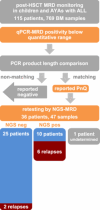NGS-MRD negativity in post-HSCT ALL spares unnecessary therapeutic interventions triggered by borderline qPCR results without an increase in relapse risk
- PMID: 40201744
- PMCID: PMC11978274
- DOI: 10.1002/hem3.70124
NGS-MRD negativity in post-HSCT ALL spares unnecessary therapeutic interventions triggered by borderline qPCR results without an increase in relapse risk
Abstract
Monitoring of minimal residual disease (MRD) after hematopoietic stem cell transplantation (HSCT) in patients with acute lymphoblastic leukemia (ALL) is vital for timely therapeutic intervention planning. However, interpreting low-positive results from the current standard method, quantitative PCR (qPCR) of immunoglobulin and T-cell receptor gene rearrangements (IG/TR), poses challenges due to the risk of false positivity caused by non-specific amplification. We aimed to improve MRD detection specificity using the next-generation amplicon sequencing (NGS) of IG/TR rearrangements for better relapse prediction. In pediatric and young adult ALL patients undergoing sequential post-HSCT MRD monitoring, we prospectively re-tested positive non-quantifiable qPCR results with NGS-MRD using the EuroClonality-NGS approach. We were able to confirm 13 out of 47 (27.7%) qPCR positive results using the more specific NGS-MRD method. Out of 10 patients with at least one MRD positivity confirmed by NGS, six relapsed (60%) 1-3.7 months after testing. Among 25 patients with all NGS-MRD results negative, two relapses occurred (8%) after 5.1 and 12.1 months. One-year RFS was 40% versus 96% and 3-year OS was 33.3% versus 94.4% for the NGS-positive and NGS-negative groups, respectively. The difference was not attributable to a varying rate of therapeutic interventions. Six patients out of 14 who had immunosuppressive treatment tapered or received donor lymphocyte infusion in response to MRD positivity developed significant graft versus host disease, leading to one fatality. This underscores the importance of enhancing the post-HSCT relapse risk prediction accuracy through NGS-MRD testing to avoid unnecessary interventions.
© 2025 The Author(s). HemaSphere published by John Wiley & Sons Ltd on behalf of European Hematology Association.
Conflict of interest statement
The authors declare no conflict of interest.
Figures



References
-
- Bader P, Hancock J, Kreyenberg H, et al. Minimal residual disease (MRD) status prior to allogeneic stem cell transplantation is a powerful predictor for post‐transplant outcome in children with ALL. Leukemia. 2002;16(9):1668‐1672. - PubMed
-
- Knechtli CJ, Goulden NJ, Hancock JP, et al. Minimal residual disease status before allogeneic bone marrow transplantation is an important determinant of successful outcome for children and adolescents with acute lymphoblastic leukemia. Blood. 1998;92(11):4072‐4079. https://pubmed.ncbi.nlm.nih.gov/9834212/ - PubMed
-
- Krejci O, van der Velden VHJ, Bader P, et al. Level of minimal residual disease prior to haematopoietic stem cell transplantation predicts prognosis in paediatric patients with acute lymphoblastic leukaemia: a report of the Pre‐BMT MRD Study Group. Bone Marrow Transplant. 2003;32(8):849‐851. - PubMed
-
- Sramkova L, Muzikova K, Fronkova E, et al. Detectable minimal residual disease before allogeneic hematopoietic stem cell transplantation predicts extremely poor prognosis in children with acute lymphoblastic leukemia. Pediatr Blood Cancer. 2007;48(1):93‐100. - PubMed
LinkOut - more resources
Full Text Sources
